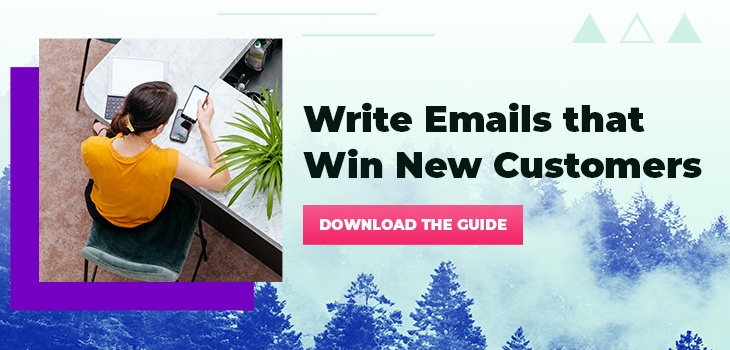People still love email, and it still works wonders for nurturing and converting leads that come in through your inbound marketing efforts. But as the noise in our lives has increased, our prospects have become pickier about the emails they’ll actually read.
That means we need to create emails that are timely and legitimately helpful if we want to further engage our potential customers. A lead nurturing campaign (sometimes called drip email campaigns) is one of the easiest ways to deliver helpful information to your prospect because they’ve already indicated a specific intent and desire for information by trading their email for a lead magnet.
So how do you write a killer lead nurture campaign? We’ll take you through the standard series of emails we use and the “why” behind each one.
👉 Easily tie your email nurture campaign into a sales funnel with this Sales Funnel Toolkit.
The Five Nurture Emails That Win
Email 1: Thanks for downloading this free offer! Stick around to hear about how our products can change. your. life.
The first email in a nurture series should be sent directly after the “trigger event” happens. The trigger event is just what it sounds like: the thing that tells the email series to start sending. For a newsletter subscription, this would be your “welcome email.” In our example, the lead has just downloaded an Email Nurturing Guide from our site.
In our example, this email should just be a quick followup to say thank you and provide the link to the guide if they need it again.
Email #1
Objective: Deliver what they signed up for
Sent from: [Your Name or Company Name]
Subject Line: Anyone order an Email Nurturing Guide for one?
Hey [First Name],
You’ve probably downloaded the Email Nurture Template for one of three reasons:
-
You’re not entirely sure what should go into a nurture sequence.
-
Starting from scratch takes way too much time. So you’re copying ours...totally fine by us.
-
You already have a sequence, but you want to improve it.
The primary objective is to deliver on your promise within a few minutes of the request. We like to call it the “thank you” email because that’s exactly what you should do in the first sentence.
Enjoy!
Lone Fir Creative
P.S. On occasion, we like to add a postscript that sets expectations and creates anticipation for another valuable email coming soon. For example: “Don’t miss the next email where we unveil a completely original idea - “How we solve all your problems with our product.”
Email 2: You have a problem, we can probably fix it.
The second email in your nurture series should begin to address the lead’s pain points. Ideally, you should use the primary pain point associated with the specific offer that triggered the email series. For instance, if a lead downloads an offer having to do with writing an email nurture series, they are looking to solve a problem related to converting leads into customers. (BTW you a customer journey map can help organize pain points with lead generators. You can read more about how to build one here.)
Email #2
Objective: Problem/Solution
Sent from: [Your Name or Company Name]
Subject Line: You have a marketing challenge. Here’s how to solve it.
Hello again [First Name],
It’s time to address the challenge your audience has and how YOU are going to help THEM solve it.
Challenges can range from a lack of time and underperforming marketing strategies to a boss that needs an email nurture series done YESTERDAY (sound familiar?).
But in this second email, we need to boil it down to one core challenge that will resonate the most with your target audience.
For example:
You’re getting leads, but they aren’t converting into customers — at least — not at the ideal rate.
Here’s the good news.
You’ve done the hardest part by identifying that you have a conversion problem.
Unfortunately, the effort it takes to diagnose the problem, test theories and measure results on your own, while also continuing your other marketing campaigns, requires serious bandwidth (notice the problem?).
Now, this is where you offer a stellar solution. For example, we offer a free strategy session to help you pinpoint your unique marketing challenge and get on the path to business growth. This provides a simple step towards the solution using a low commitment call-to-action that feels like a no brainer!
Until next time,
Lone Fir Creative
P.S. In this postscript, provide a bit of social proof or context explaining how these strategy sessions truly have no strings attached. Briefly explain how they are designed to provide as much value as humanly possible in 30 minutes. And don’t be afraid to add another link here to make sure they didn’t miss the opportunity to click.
Email 3: Look! Someone else says we helped them fix the same problem you have.
This is the part of the email series where you begin to build a little more confidence in how your product or solution can solve the lead’s problem. One of the best ways to do this is through a real customer testimonial. You can pull these from social media, Google or even client feedback gathered by your staff.
Email #3
Objective: Success Stories
Sent from: [Your Name or Company Name]
Subject Line: [Insert Here] a customer quote that makes you sound awesome
Heyyyyyy,
Prospective clients need to know that you’ve had success, and your solution is actually worth paying for. So how do you tell them you have a few wins under your belt?
A. Tell them how much money you’ve made?
B. Tell them how long you’ve been in business?
C. Display your knowledge of craft coffee beans?
Answer: none of the above (although, if you do have some coffee recs, we’ll gladly take them 😉).
Nobody believes anything you say because they know you’re trying to sell them things. For instance, behold our defining characteristics:
-
We are a Hubspot Platinum partner & StoryBrand Certified.
-
We use all sorts of cool technology because we are smart, digital people.
-
Our team’s combined knowledge of fancy coffee, obscure movie references and “lunch culture” are valuable to your company’s growth.
Did that compel you to trust us? Maybe — but you’re likely just thinking, “Cool, but I still don’t see how that helps me or why I should trust them.”
In a world where you can say whatever you want on the internet, customers are more suspicious than ever of claims and promises coming directly from a brand. However, word of mouth and the testimony of a satisfied customer is more precious than gold. So in this email, we want to present a real customer testimonial who already tried your product or service and loved it. Like this totally real and not made-up testimony, for instance:
“After implementing marketing advice from a team of hipsters (I think what he really meant was “brilliant and friendly”), we started getting results! Now I look like a marketing genius!” — CMO of Technology Company.
Until next time,
Lone Fir Creative
P.S. You spent this whole email trying to prove yourself. Right here is a good spot to remind them of the action you want them to take. For example, “Don’t forget to schedule a free strategy session with Lone Fir Creative to help you pinpoint your unique marketing challenge.”
Email 4: We alllll got problems
Part of addressing a person’s problem is letting them know that you’re there with them. Email number four is where we write the “we totally get how you feel" email. Bonus points if you can include a case study where you solved that problem for another person.
By the way, if you’re having trouble defining the main problem your target audience has and empathizing with them, you might need to start with your core messaging before writing this lead nurture series.
Ok, now on to our example of the empathetic email.
Email #4
Objective: Empathy
Sent from: [Your Name or Company Name]
Subject Line: 99 problems and they’re all lead nurturing
Heyyyyyy again (there’s only one more email in this series. Do you miss us yet?)
The reality is, there’s always resistance to purchasing your product or service. People just aren’t going to see how awesome you are right away (like we did obviously).
So in this email, we don’t just want to tell them their objection is silly and move on to features and benefits. We want to empathize and put words to the primary objection they have. This leads them to overcome their own objection. For instance:
“We know you’ve tried a bunch of marketing tactics, and you don’t feel like any of them work. Maybe you’re getting leads, but you aren’t sure where they’re coming from. You’re afraid to turn off one marketing source in fear of losing the leads you do have. All the while, you still need more leads! Listen, we’ve been there before.
We get it. There are probably a bunch of challenges keeping your marketing efforts from taking off. That’s why we always start with a free strategy session so we can collectively understand where you are, where you’ve been and where you want to go.”
...or something super general like that.
This one isn’t the easiest to write. After all, you know the objection is real, but you’re confident that your solution is the answer. The goal is to get them to weigh their options more clearly and consider why you’re the best choice.
- Lone Fir Creative
P.S. Remind them about that thing you keep bringing up in each email. It’s a very subtle way of mentioning the solution to their problems again. Just for the sake of an example… “Ready for a growth strategy that gets you where you want to go? Schedule a free strategy session with our team (they are really fun.)”
Email 5: Straight up, tell them they need to pick up what you’re putting down.
The last email should be a hard sell for your product or service. Don’t be shy here. Just tell them how you can help and include a very clear call to action (CTA). If the lead doesn’t know precisely what you want them to do, it creates one more point of friction in getting them to do it.
Email #5
Objective: Hard Call to Action
Sent from: [Your Name or Company Name]
Subject Line: Hi. You should just go ahead and buy this.
Hello for the last time (or maybe not if you click this link)
Ah, the final email. This is where you get down to business and explain how you really can solve the big problem your audience is having.
Let’s be realistic; you’re not solving all their problems, and promising that you will isn’t going to get you anywhere. In this email, you want to present how you can help them and what success feels like. You’ve been there, you’ve done that, and now you can help your audience experience that same satisfaction every time a new lead pops up in their inbox.
If you’re trying to sell a single product, this is where you link your BUY NOW. But since you can’t add “growing your business with marketing” to your cart, here’s how you would hypothetically spell out the “plan” to get started:
-
Click this link to schedule a free strategy call since you didn’t in any of the other emails (you know you’ve always wanted to).
-
Talk to a team of hipster marketing experts.
-
See if it makes sense to partner with some super fun marketing wizards (that’s us) to find a unique marketing plan that works for your business.
Lone Fir Creative
P.S. I think we’re done with postscripts for now. But if you have any more questions and you really don’t want to schedule a free call (even though we’d love to talk), feel free to visit our blog for marketing inspiration.
Best Practices for an Effective Lead Nurturing Strategy
As you write and build your email nurture series, there are some best practices you can follow to make your emails more effective.
1. Drive towards actions appropriate to the buyer’s journey stage. Not every lead is is ready to buy. In fact, most leads aren’t. Make sure that the action you are encouraging them to take is appropriate to the stage of the buyer’s journey that they are in. That might be another lead magnet, a free consultation or a number of other things that aren’t your primary product.
2. Use marketing automation. An automated email series not only saves you a ton of work, it also ensures leads aren’t falling through the cracks. There are several platforms out there that will do this, including Mail Chimp, HubSpot (our favorite) and Constant Contact.
3. Get feedback from your sales team. The whole purpose of nurturing emails is to convert leads into customers. Your sales team is going to know the most about what it takes to convert customers and the conversion rates of leads coming in from your nurture series. Run the series by them before it’s launched and then check in after a while to see if they have feedback.
4. Watch your metrics. Evaluate the open rates of each email in your drip campaign and a/b test some new subject lines to see if you can improve them. Check your click-through rates (CTR), are people engaging with your content? Test out different types of content they can click on and different CTAs to see if you can optimize your CTR.
5. Don’t destroy your email list. If someone is in your email nurture series, omit them from receiving other emails. This prevents them from being bombarded by broader efforts like email newsletters while you’re sending them targeted emails in the drip campaign. Remember, the nurturing process is designed to build trust with our prospects.
6. Include the option to unsubscribe. Most email platforms require you to include an unsubscribe option in your emails. This is important to not only comply with email regulations but also to make your lead feel secure. If they don’t want to hear more from you, don’t block the exit.
7. Align your content marketing efforts with your email campaigns. Content marketing can offer a ton of value to your business. One very practical but often overlooked use is to feed relevant content into your email marketing campaigns. It might go without saying, but the more valuable content you have stockpiled, the easier it is to offer value in your email content. This can include blogs from your website, white papers relevant to your industry (or your target audience’s industry), and even helpful infographics that make complex topics simple.
8. Trigger tasks for sales-ready leads. Once your leads have engaged with enough of your content or taken specific actions that indicate they are interested in your product, you want your sales team to know. Set up a workflow that automates a task or notification to your sales team that prompts them to reach out.
9. Start with an effective lead generation tool. You could write the most brilliant nurture series only to have it fail because it started with a flawed lead generator. A good lead generator converts leads that are a good fit for your product or service. That means you need to offer incredible value that also ultimately leaves them wanting to hire you or purchase your products. Some lead generators that we’ve seen work are webinars, ebooks, demos and free consultations. Whatever you choose, it’s usually safe to err on the side of offering more value.
If you want an even more detailed walkthrough of writing an effective lead nurture series, we’ve packed all the tips and tricks we’ve learned from writing a ton of sales funnels for clients into it a complete guide. Download it here.







